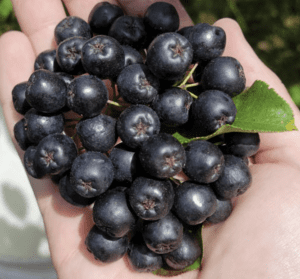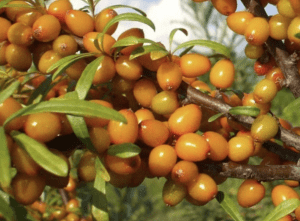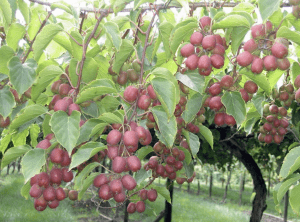Building Resiliency: Climate Smart Adaptations for Fruit Growers
Author: Evan Lentz
Evan.Lentz@uconn.edu
Reviewers: Shuresh Ghimire and Mary Concklin, UConn Extension
Publication EXT106 | March, 2025
Introduction
Extreme weather events can give fruit growers a preview of what producing food in a rapidly changing climate might entail. The general trend of increasing
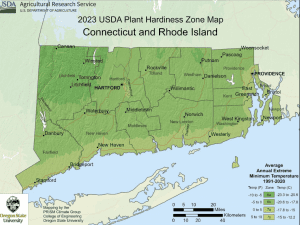
temperatures was solidified and reflected in the recent adjustment to the United State Department of Agriculture (USDA) plant hardiness zones. Connecticut gained gained a new warmer 7b zone along the coastline, while losing the coldest 5b zone in the northwestern region [Figure 1].
Coupled with extreme weather events such as late Spring frosts, unprecedented amounts of rainfall and flooding, and summer hailstorms, thoughtful climate adaptation strategies are essential. Since mitigation efforts are as varied as the potential climate challenges, understanding the entire breadth of options is the best place to start.
Below are some climate-smart considerations aimed at increasing the resiliency of a fruit-producing operation. It is by no means a complete presentation of climate-smart adaptations, but practices that will best assist any operation faced with the contemporary challenges of fruit production.
Site Selection
Site selection is the first, and arguably most important, preventative climate adaptation tactic, as it relates to both profitability and sustainability. A land evaluation, prior to purchase or planting, offers the opportunity to explore a range of site variables and conditions. This can also be done when expanding a current operation to a site or even before putting a new field into production.
Some major considerations are:
- Soil Drainage – the ability of a site to adequately drain excess water. Standing water causes a range of issues for fruit producers. Sites that are low-lying, very flat, or contain heavy, clay soils may prove to have poor soil drainage.
- Air Drainage – a site’s topography can affect the drainage of cold air, which tends to accumulate and linger in low or flat areas – termed frost pockets
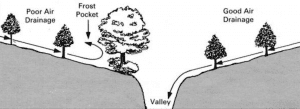
Figure 2 – Cold air movement in an orchard, depicting good air drainage and the creation of frost pockets (NCSU, 2016) (Figure 2). A site with a gentle slope (4-8%) is ideal for fruit production, allowing cold air to drain away from plants and reducing the risk of injury.
- Soil Depth – the distance between the surface and any dense layer that might restrict the root growth of plants. This could include soil parent material, a hardpan, or the seasonal high-water table.
- Soil pH – Most fruit crops have different soil pH requirements. Blueberries prefer a very acidic pH of 4.8 while apples prefer 6.0-6.5. A simple soil test can help you make informed decisions about a site’s pH.
- Annual Minimum Temperatures – Production can often be limited by the minimum temperature a site experiences in a year. Even cold hardy apples may be injured when temperatures go below -20°F. For V. vinifera grapes, winter temperatures below 0°F can cause winter injury.
- Annual Growing Degree Days – Different fruit crops and varieties require different periods of time above a certain temperature to complete their life cycle, and produce fully ripened fruit. This is measured using degree days (DD), which begin to accumulate at temperatures often above 50°F. Shorter-season varieties may be required at sites with insufficient DD accumulation.
- Slope & Orientation – In addition to air and water drainage, the slope and orientation of land can further influence fruit production by affecting the plant’s access to sunlight. Special consideration should be given to sites on slopes, specifically the direction of their exposure to sunlight. A south facing slope will allow plants to intercept more light than one on a north facing slope.
Site Selection Resources:
- USDA NRCS Web Soil Survey: https://websoilsurvey.nrcs.usda.gov/app/
- NEWA – DD Calculation: https://newa.cornell.edu/
- Land Evaluation Video: https://ctfarmrisk.extension.uconn.edu/farmeval/
Varietal Selection
Just behind site selection in importance, the proper selection of plant material offers the next best defense against a rapidly changing climate. Plant breeders have been working for decades to develop fruit varieties well-adapted to a variety of abiotic and biotic stresses. Cold hardiness, pest resistance, and precocity are all parameters that affect a plant’s ability to endure the challenges of unpredictable weather. This includes proper scion and rootstock selections.
- Precocity – A precocious variety is one that flowers and fruits early. Precocity is desirable for multiple reasons, mainly due to the fact that some sites might not have adequate growing degree days (DD) for fruit to fully develop and ripen. However, many growers may choose to grow early (or late) varieties to extend the window in which their consumers can access fresh local fruit. Additionally, late-season varieties face the challenge of accumulating late-season disease pressure and multiple generations of insect pests, requiring additional management and inputs late in the season.
- Cold Hardiness – If your site is revealed to have questionably low minimum annual temperatures, cold hardiness might be a trait you select for in yourvarieties. For example, Frostbite™ apples, developed by the University of Minnesota, boast a cold hardiness of -30 to -35°F. For wine grapes, cultivars have been extensively evaluated for varying degrees of cold injury [Figure 3]. This information should be used to inform varietal selections.
- Pest Resistance – Pest resistance is perhaps the most important group of improvements in our modern fruit varieties. Essential to practicing integrated pest management (IPM), resistant varieties offer growers the opportunity to avoid certain pest problems altogether. The Bluejay variety of blueberries offers great disease resistance to Mummy Berry, one of the region’s biggest blueberry diseases, providing resistance to both its primary and secondary disease cycles. Likewise, apple varieties Enterprise, Fuji, and Tsugaru have been revealed to be highly resistant to fireblight.
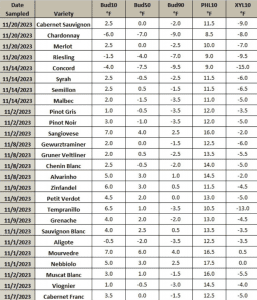
There are multiple avenues for growers to ensure that they are making the proper plant materials selection. Nurseries often do a great job marketing the varieties that they offer, highlighting each’s beneficial traits. The New England Management Guides (Small Fruit and Tree Fruit) also provide some great regional recommendations. Lastly, always consult with the local Extension educator if you have any questions not answered by the nurseries or existing literature.
Cultural Management
Good cultural management is an incredibly broad topic. It includes pest management, plant nutrition, and water management. A snapshot of some of the most important cultural practices as they relate to climate change adaptation is presented below. This is by no means a complete list but provides a sufficient place to begin for most fruit growers.
Integrated Pest Management (IPM)
Integrated pest management (IPM) is a holistic approach to managing pest – a systems approach that considers the entire growing season, the life cycles of
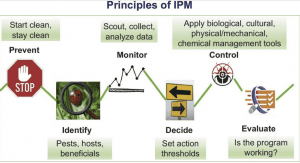
both the crop and the pest, and one that is aimed at reducing the detriments of pest management, mainly environmental and economic impacts (Figure 4).
IPM includes site and plant material selection, offering a preventative approach to pest management. IPM is also heavily reliant on the use of scouting and trapping, allowing more informed and corrective action decisions to be made. Many IPM practices are simple cultural measures, such as dormant pruning to remove diseased wood, canopy thinning to increase airflow in the summer months, or mulching blueberries in the early spring to cover overwintering mummies. When it comes time to apply pesticides, it’s important to consider each material’s efficacy, recommended rates, and FRAC/IRAC group. Materials must always be applied in rotation or with multiple FRAC/IRAC groups in a single mix to avoid developing resistant pest populations. For more information on IPM, please visit the UConn Extension IPM Website: htps://ipm.cahnr.uconn.edu/
Abiotic Stress Management
Anything that can be done to keep plants thriving is essential. There is a lot to be said about a plant’s resilience when it has the proper environmental conditions to thrive. Maintaining this innate resilience is key when facing the unpredictability of climate change. Since there are plenty of environmental factors that cannot be controlled in an orchard or vineyard, it is important to focus on those that you can.
- Water Management – Managing water in a fruit operation can be challenging and is largely dependent on natural precipitation, opening the door to stress associated with both drought and/or flooding. Supplemental irrigation in the dry months and ensuring that excess water has a place to go in the wetter months will help to mitigate the variability in precipitation over time.
- Drainage – Ideally, drainage would be a pre-plant consideration and would be in place prior to an issue arising. However, some growers may have noticed that over time, a site is much wetter than it used to be – the nature of a changing climate. In these cases, drainage can be readily installed in existing operations. Tile drains and curtain drains are the most common types of drainage installed in orchards, each with their own costs and benefits.
- Irrigation – Installing irrigation would ideally be a pre-plant consideration but systems can be installed after the fact. Even if the irrigation is used once every five years, it might still be worth the investment. There are multiple options for irrigation, including drip, trickle, and overhead irrigation. A water source should also be considered when selecting a site, whether you have access to a well for regular irrigation or just a pond for emergencies.
- Soil Management
- Parameters such as soil pH, nutrition, organic matter, and cover all factor into climate change adaptation. The soil environment can be managed to some degree.
- Soil Organic Mater (SOM) – consists of plant residues and living microbial biomass, found in both active and stable forms (termed detritus and humus respectively). The benefits of maintaining sufficient SOM levels are numerous and include:
- Enhanced aggregate stability, leading to improves water infiltration, aeration, and reduced runoff/erosion;
- Improved water holding capacity, reducing waterlogging, and drought stress;
- Increased soild cation exchange capacity (CEC) allows for sustained access to nutrients;
- Increased buffering capacity, which resists swings in soil pH;
- Accelerated decomposition, increasing availability of plant nutrients;
- Enhanced soil biodiversity, allows for suppression of pests and diseases;
- Enhanced pore space, leading to aeration, and increased root growth
- Parameters such as soil pH, nutrition, organic matter, and cover all factor into climate change adaptation. The soil environment can be managed to some degree.
Cover
Maintaining an adequate cover in the orchard will ensure that efforts to improve soil health are sustained. A vegetative cover, such as grass, works to hold the soil in place, reducing the risk of erosion, compaction, and helps to increase water infiltration.
Nutrition
Proper nutrition is not only essential for producing a good crop, but it also helps to reduce plant stress, allowing for greater resilience in the face of climactic challenges, whether they be biotic or abiotic in nature.
Soil tests should be conducted once every two years. Foliar tests can be done every year and are the best tool currently available for evaluating the nutritive status of a plant. Fertilizer applications should be informed by at least one of these tests. Nutrition standards for just about every crop type have been developed and testing labs like the Soil Nutrient Analysis Laboratory at UConn will provide specific, tailored soil amendment recommendations based on your test results.
- pH – soil pH influences a range of processes in the soil environment, including the availability and uptake of nutrients. Any soil test will provide a site’s soil pH reading. Corrective action recommendations will be included in the results.
Diversification
Diversification is an excellent tool for building farm resiliency. Diversification relies on the fact that each crop and/or cropping system has its own unique requirements and parameters, meaning each will respond differently to changing climate.
Some crops might be more tolerant of late Spring frosts, while another may provide an early season cash infusion. Likewise, alternative production systems can help to extend the growing seasons or provide additional protection from the environment.
Diversification is really a process of adapting. If something doesn’t work out this year due to a pest issue or flooding, diversifying operations will ensure an alternative source of revenue.
Below are some recommendations for diversifying your operation. Introducing news crop types is one of the easiest ways to diversify. A grower’s familiarity with apples is easily translated to peaches or even bush fruit like blueberries. Much of the equipment and culture is shared between these crops.
For those already fairly diversified, there is a host of less well-known fruit crops that could offer an, operation a marketing edge in addition to resiliency.
- Currants, Gooseberries – Ribes spp.
-
- A group of bush healthy fruit with varying levels of disease, drought, and cold tolerance. Some tolerate partial sun and are utilized for both fresh consumption and processing.
- Aroniaberry, Chokeberry – Aronia mitschurinii
-
- An incredibly healthy small pome fruit crop with high levels of antioxidants and a unique astringent flavor. This crop accepts a variety of growingconditions, including a wide pH range. It is native and very cold hardy. It is primarily used for processing jams, jellies, and baked goods – like cranberries (Figure 5).
- Honeyberry, Haskaps – Lonicera caerulea
-
- Haskaps are another bush fruit, with elongated blue fruits. It is cold hardy, matures early and is high in vitamin C.
- Seaberry, Common Sea Buckthorn – Hippophae spp.
-
- Another cold hardy bush fruit intended for processing. It has bright orange berries that are used around the world to produce jams, jellies, juices, and skin care products (Figure 6).
- Kiwiberry, Hardy Kiwi – Actinidia arguta
-
- This is a cold tolerant vining crop with small green fruit with a flavor and texture reminiscent of their tropical counterparts (Figure 7).
In addition to crop diversification, it might be worth exploring alternative production systems for existing crops. Systems such as tabletop strawberries or brambles grown in high tunnels offer a range of benefits from season extension to pest avoidance to early development.
For more information on alternative production systems, including protected culture or controlled environment agriculture, contact the local Extension specialist.
Pollination Support
Most fruit crops require pollinators to set fruit. Pollinator activity is largely influenced by weather during the critical pollination period. If it is too cold or rainy, pollinators will not be as active – effectively shortening the period for pollination to occur and potentially affecting fruit set.
Many fruit growers already purchase or rent pollinators during bloom. However, ensuring a healthy population of native pollinators is essential. Pollinator gardens and habitats can provide native pollinators with support year-round, ensuring access to food and shelter.
Many companies have been selling pollinator seed mixes for years. Even minimally managed-pollinator gardens, such as spreading seed along the woods edge can provide benefits. For more information, please check out the UConn Pollinator Program: htps://ipm.cahnr.uconn.edu/pollinators/
Resources
Bradshaw, T. N.D. Site selection and preparation in Vermont apple orchards. UVM Extension. htps://www.uvm.edu/~orchard/fruit/treefruit/tf_horticulture/AppleHortBasics/SiteSelection.html
Fennell, A. 2004. Freezing tolerance and injury in grapevines. J. Crop Improv. 10:201235.
Fenton, M., Albers, C., & Ketterings, Q. 2008. Soil organic matter. Agronomy Fact Sheet 41. Cornell Extension.
Kime, L. 2023. Diversification of your operations, why. Penn State Extension.
htps://extension.psu.edu/diversification-of-your-operation-why
Kostick, S.A., Norelli, J.L., & Evans, K.M. 2019. Novel metrics to classify fire blight resistance of 94 apple cultivars.
Plant Pathology 68, 985-996. htps://doi.org/10.1111/ppa.13012
Minnesota Hardy. 2023. Frostbite™. University of Minnesota Extension. htps://mnhardy.umn.edu/frostbite
Suszkiw, J. 2023. USDA unveils updated plant hardiness zone map. USDA ARS. htps://www.ars.usda.gov/news- events/news/research-news/2023/usda-unveils-updated-plant-hardiness-zone-map/
Zilia, K. 2016. Grapevine cold hardiness. WSU Viticulture & Enology. htps://wine.wsu.edu/extension/weather/cold-hardiness/
The information in this document is for educational purposes only. The recommendations contained are based on the best available knowledge at the time of publication. Any reference to commercial products, trade or brand names is for information only, and no endorsement or approval is intended. UConn Extension does not guarantee or warrant the standard of any product referenced or imply approval of the product to the exclusion of others which also may be available. The University of Connecticut, UConn Extension, College of Agriculture, Health and Natural Resources is an equal opportunity program provider and employer.
